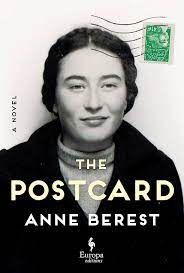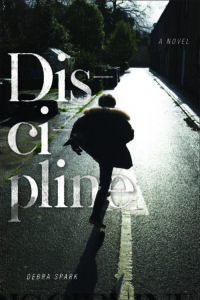I don’t think of myself as a reader or writer of crime novels, and yet (knocking on my own skull to see if anyone’s inside) almost all of my novels do have a crime—or a strange disappearance or a person concealing their identity or a similar mystery.
My latest novel, Discipline, involves three stolen paintings, a no-doubt-about-it-crime story, inspired (in part) by reading about a man fleeing from police who, perhaps to conceal evidence, burned two of a famous painter’s canvases by the side of the road.
I realize (more knocking on my own head) that I loved Donna Tartt’s A Secret History and am a fan of Kate Atkinson’s fantastic Detective Brody series, so I am as deluded about my reading as my writing. That said, here is a list of crime books that don’t exactly read like crime books, because they take on a lot more (emotionally, culturally, historically) than the apparent crime that is (very much) at the heart of the novel.

Anne Berest, The Postcard
One day a mysterious postcard arrives in Anne Berest’s mother’s mailbox. On it, and in an unfamiliar hand, are the names of three of her relatives who died in the Holocaust. No signature. Who sent this and why? Though she is Jewish, Berest has not really been exposed to the faith or culture. She only investigates who sent the postcard and why years later, after an anti-Semitic incident at her daughter’s school. The result is a long book that is a quick read, ranging between past and present, as Berest describes her remarkable family’s history, up to and during the war, when some perished and others worked for the Resistance. The story is also about its own telling, so we watch Berest as she tracks down clues, interviews strangers, and finally solves the mystery of the postcard and what it means, for her at least, to be a Jew.

Lan Samantha Chang, The Family Chao
In The Family Chao, Lan Samantha Chang kills off the patriarch of a Midwestern Chinese-American family, and, in good detective-fiction style, there are plenty of suspects, given how unlikeable the man was. Fate is a suspect, too, as the death might have been an accident. The story reads less like a whodunit than a Russian novel, because it is one in disguise, a loose retelling of Dostoevsky’s The Brothers Karamazov. The action starts after the adult Chao children return home for Christmas, just after their mother decides to leave her husband for an extended stay in a Buddhist temple. The drama focuses on family angers and hurts, as well as a community of Chinese-Americans whose lives revolve around the family restaurant that is the father’s dynasty, legacy, and weapon.

Jane Pek, The Verifiers
Jane Pek examines generational differences in Chinese-American families, even as she places her protagonist Claudia Lin at the Verifiers, a secretive firm for daters who wonder if their online matches are honest about their identities. When one client disappears, Lin (who adores mystery novels) decides to investigate, helping herself (without permission) to her agency’s files and tracking software. How do we understand intimacy and trust in contemporary relationships? Though Claudia’s a whiz with computers, she’s someone whose life raises this question more than answers, given she steers away from romantic attachments. The novel pokes gentle fun at the detective novel genre and Chinese stereotypes, while ringing an alarm bell about the dangers of dating (and existing) in the digital age.

Margot Livesey, The Boy in the Field
Three siblings, walking home from their school in a small town outside Oxford, England find a dead boy in a field. Who is he? What happened to him? The novel answers this mystery eventually but the real mystery is with the three siblings. How will they incorporate this terrible find? One sibling tries to figure out what happened, another finds herself interested in her own blossoming sexuality (even, because she assumes the boy was killed by a man, as she considers the potential darkness of any male partner), and a third (who is adopted) is prompted by the drama to search for his birth mother. The crime is solved, but the real mystery is with the evolving relationships in, and outside, the family.

Constance Debré, Love Me Tender
The criminal in this memoir-novel is the narrator accused (unjustly) of pedophilia by her ex, now that they are in a difficult custody battle over their son. The marital break-up had been amicable until the author decides to explore her sexuality and recast herself more broadly, quitting her job as a lawyer, downsizing her material life, while she upsizes her sexual life with women. Debré’s book is not for everyone and her rejection of the status quo seems at times the admirable, free experiment she claims it is and at times like an extended pat on her own quite muscular back, since with daily swims she strips her body, as well as her life, to the bone. Even so, the drama of her case and desire to recreate herself intrigues, as does her swift, tight writing, and the moments when her emotional life and philosophical beliefs seem at odds.

Susan Perabo, The Fall of Lisa Bellow
This novel tells the story of two middle-school girls forced to the floor during a robbery, one of whom is subsequently abducted. Though the novel explores the possibilities of what might have happened to the kidnapped girl, the focus in on those left behind—specifically the girl who isn’t taken and her family. How does the girl handle her survivor’s guilt, especially given she never much liked Lisa Bellow, the “popular girl” in her grade? How does her mother handle her relief and concern for her daughter? And what about her brother who has his own crisis to weather, after a traumatic baseball injury? Despite its dark subject, this book, which is so astute about parents and teens, pushes toward healing by letting the characters reckon with the imagined truth and the actual truth in a genuinely complex way.

Colson Whitehead, The Nickel Boys
The crime of murder as experienced by the near victims is the subject of this horrifying, infuriating yet compelling tale of young Black men at a juvenile reform school in 1960s Florida. The Pulitzer-Prize winning novel is based on a real place and will make you enraged, astound you with human evil, and impress you with how victims endure psychological and physical pain. It will also amaze you with the formal trick, late in the novel, that recasts the historical nightmare to underline the long reach of such tragedies.
***


















